Ice accidents during the 2017 Ice Season
The following is based on reports found on the WWW. This year a few non-fatal accidents have been included for the lessons they have.
As always, bad outcomes generally come from a mixture of poor decisions and bad luck. Almost all of us make poor decisions from time to time and luck usually keeps them from becoming fatalities. Luck is random so the less we depend on it the better our odds of staying out of trouble.
Summary Data
Total North American fatalities: 52
Drowning:43. Most of the drowning victims would have survived if they had flotation, ice claws, a throw rope, a buddy and a test pole of some sort. Victims that had flotation or ice claws: none.
Hypothermia fatalities: 0 (probably). People without floation usually surcome to cold water incapaciation in a few minutes and can't stay on the surface. With flotation most people can survive an hour or so.
Blunt force trauma:(crash): 9. Eight of these occurred between December 24 and January 18. Five of them occurred in one week in January. Based on data from Wisconsin, many blunt force trauma victims are riding fast, at night and with a blood alcohol concentration well over 0.08%
Mode of travel:
- Snowmachine: 22
- Foot: 18
- Heavy Vehicle (tracked vehicle, Bobcat, Tractor)
- Car/truck: 4
- Atv: 3
Male: 49
Female: 3
Age
- age 0 to 4 none
- age 5-12 5
- age 0-17 7
- 18-24: 4
- 25-34 7
- 35-49 7
- 50+ 20
- 66+ 8
Heavy Vehicles: Between two and five people died in rapidly sinking machines that broke trough. There was a BobCat, a tractor and a tracked transportaion vehicle In some or all cases the victims were unable to open the cab/windows and get out quickly enough.
Activities
- Snowmobiling 25
- Fishing 8
- Playing 7
- Working 5
- Walking 3
- Driving 2
- Walking Dog 1
- Skating 1
Where accidents occurred
- NY 11
- MI 5
- ONT 5
- QUE 5
- WI 5
- NH 4
- VT 3
- IL 2
- KS 2
- ME 2
- ALB 1
- CO 1
- IA 1
- MN 1
- PA 1
- SAS 1
Link to a newspaper article on the high rate of fatalities in the North East
Reports:
November 5, 2016,2 PM Big Lake, 40 mi north of Anchorage AK
A 47 year old man went skating on Big Lake . It had a light snow cover and some dark (slush) areas . He broke through. A woman who lived on the lake called 911 and then went out on her paddle board. She got within 10 feet of the man but he was unable to hold on enough to pull him out. In the mean time, Rescue personnel were having trouble finding the location. They rescued the man promptly after arriving. He had been in the water for between 15 and 30 minutes. The woman video'd the rescue (see title link above).
The weather history (for Ancorage) showed mostly above freezing weather until the 22nd of October. from then to the 28th there were 39 freezing degree days. That is enough to make up to three inches of ice, depending when the lake caught. There was a 17 thaw degree day warm spell from the 29th to November 2: enough to melt a couple inches and, finally, there was enough cold in the last three days before the incident to add another inch. These numbers are rough but they clearly suggest the ice was not overly thick.
The man was wearing what looks like a full wet suit. He did not have the basic tools: A test pole, life jacket, ice claws, throw rope, buddies and the knowledge of how to use them. Skating on snow covered ice with thin ice and no tools is simply Russian Roulette....glad it turned out well.
December 9, 2015, Geneva WI, Lake Como.
A man walked onto the ice covered lake about 200 to 300 yards and then fell through. A 911 call was placed at 1:15 PM by security people at a nearby golf course. The body was found about 5:30. The ice was described as quite weak.
The weather from November 23 to December 6 was above freezing. A lakeside resident commented to the news that the ice had only been in for a couple of days before the accident. It was windy from the 6th on through the accident time (12/9/2016). The number of freezing degree days from the 6th to the accident was about 25; enough to grow about 1-3/4" and less if the lake did not catch at the beginning of the cold spell.
A life jacket and ice claws probably would have saved the day.
Lake Como is a large but shallow lake (max 11 feet deep). Wind will inhibit catching, especially if the temperature is near freezing.
December 10, 2016, Morning, Boone IA, Don Williams Recreation Area
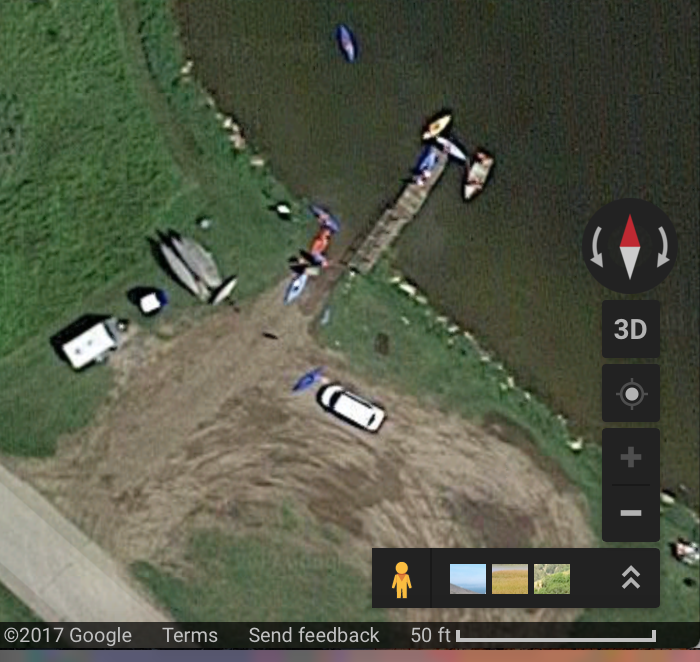
A 56 year old man drowned about 40(?) feet off the shore attempting to save his dog. A person driving by notice the dog swimming in the water and then a body. He called Rescue. One of the firemen (in a rescue suit) broke through about 15 feet off shore. Temperatures at the time were in the low 20's so the ice would have been cold. The fire chief commented that pets have a different body structure and usually are able to get out after breaking through. People tend to become incapaitated before they can self rescue. His advice is to call 911 and let them rescue a pet who has broken through.
The temperature and wind record and the picture of the ice in the news report suggest that the ice did not come in until as late as the 9th.
Weather graphs from weatherunderground.com
December 16, 2016, Aproximately 6:30 PM, Vienna Township, MI (Northern MI).
A 69 year old fisherman broke through the ice. Someone saw or heard the victim and had to drive 7 miles to find cell service. First responders arrived 50 minutes after receiving the call. The victim was recovered.
The weather history suggests that there was no December ice before about the 13th. There were about 40 freezing degree days between the 13th and the accident on the 16th. Depending on when the lake caught and how much snow there might have been a couple inches of new ice but there also could have been lots of new-ice holes or snow insulated thin ice. There was about an inch of snow on the 13th and 14th and this is a pretty windy place. Any drifts could have retarded ice growth.
A life jacket, ice claws, a spud and a buddy with a throw rope would have improved the odds significantly.
December 17, 2016, Otsego County Lake MI
A 61 year old man fell through the ice and died while fishing alone . Rescue was called by two fishermen who were checking the ice and found his snow covered vehicle and a bait bucket. The weather history and situation were similar to the December 16 accident.
December 20, 2016, 5:30 PM, Winslow, IN
A 12 year old boy and a 12 year old girl decided to play on ice near their home while they waited a few minutes for dinner. They both broke through and both drowned.
Temperatures for the first half of the month averaged above freezing. It hit 66 degrees three days before the accident which may have melted some or all of any ice that existed at the time. The temperatures two days before the accident were well below freezing. Any open water would have probably frozen. Depending on when it cought it could have gotten to an inch or a little more by the time of the accident. The temperature at the time of the accident was below freezing so the specific strength of the thin ice should not not have been compromised by thawing.
Somehow we we need to get Gordon Geisbrecht's message ("Stay Off the Ice or Prepare to Go Through") more in the public eye. Perhaps it should be put on on the THIN ICE signs that are placed on most urban and suburban ponds. The thin ice signs generally stay up no matter how thick or strong the ice is.
December 21, 2016, late at night, Rock River, Moline IL
An 18 year old man broke through the ice on the Rock River. His companion did not fall through and called 911. It is thought they went out on the ice in an area where they played as they grew up. This appears to have been an impulse situation.
The weather leading up to the accident was cold although on the day of the accident the temperature peaked at 41 degrees with some sunshine.
December 21, 2016, 1:35 PM, Lumsden, Saskatchewan
A 33 year old man broke through ice while driving a BobCat on private land. His body was recovered the next day. The machine weighs about 5400 lbs with an additional 1500 lb of lifting capacity. A BobCat has a very short flotation time.
The first half of the month was mostly below zero.
December 23, 2016, 3:30 AM, Delta PA (south central PA),
A 29 year old man was walking with some co-workers by a frozen quarry pond. He told them he could walk across the ice. His friends called for him to come back but he kept going, broke through and drowned. The average temperatures got below 32 on about the the 15th. Between then and the accident there were about 24 freezing degree days and 23 thaw degree days (no net ice growth from cold air). Radiational cooling may have accounted for most of the ice thickness.
The day before the accident reached 55 degrees. This was bravado gone wrong.
December 24, 2016, 9PM, Mayfield NY, Sacandaga Lake
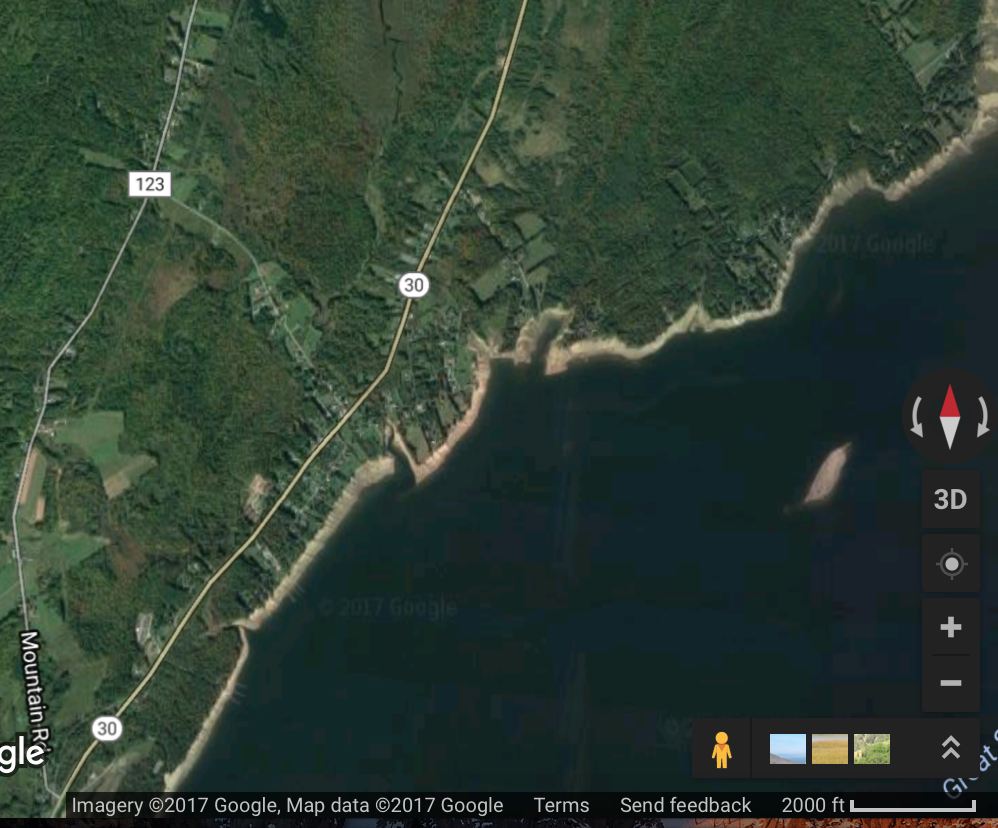
 Closer picture showing stone piles that line most of this manmade lake.
Closer picture showing stone piles that line most of this manmade lake.
A 24 year old man, riding a high powered sled hit rocks near the shore. The initial collision redirected him into another rock pile.
December 24, 2016, 7:15 AM, Mc Farland, WI, snow covered Lake Kegonsa
A 74 year old man and a 15 year old boy were riding across the lake on an ATV, About half a mile from shore they broke through. They were unable to self rescue. A good Samaritan called 911. Both the victims were rescued by firemen with a rescue sled. They both recovered.
There was some warm weather the three days before the accident that may have created some pressure ridges. These ridges often occur in swarms on the first day the ice sheet warms up.
December 31, 2016, 5:15 PM, Aurora CO, Pond at Olympic Park
A 6 year old went missing. A three day search did not find him. A search dog picked up his scent near the frozen pond. There was no observed breakthrough hole on the ice. Searchers found the body under the ice. The pond was about 1.2 miles from where the boy lived.
There are two fountains in the main part of the pond. There was no mention of aerating the pond in the winter months but the ice appeared to have formations that looked a lot like aeration patterns. Roughly one person/year dies in an aerated, ice covered pond.
It looks like the pond ice probably came in in a cold spell from the 16th to the 19th. The cold spell had 62 freezing degree days (roughly 4" of ice growth). The frequent clear skies in the area could have provided significant additional growth. The warm weather that came after the 19th could have melted 5" of ice. The peak temperature on the 30th was 62 degrees. It was around 40 at the probable time of the accident.
January 1, 2017, 1:40 AM, Argyle NY, Cossayuna Lake
A snowbiler hit a rock at the edge of the lake while traveling at high speed.
January 5, 2017, 11 PM, Stump Lake Bridge, Rice Lake, WI
A 42 year old man, riding solo, broke through the ice near the Stump Lake Bridge at night.
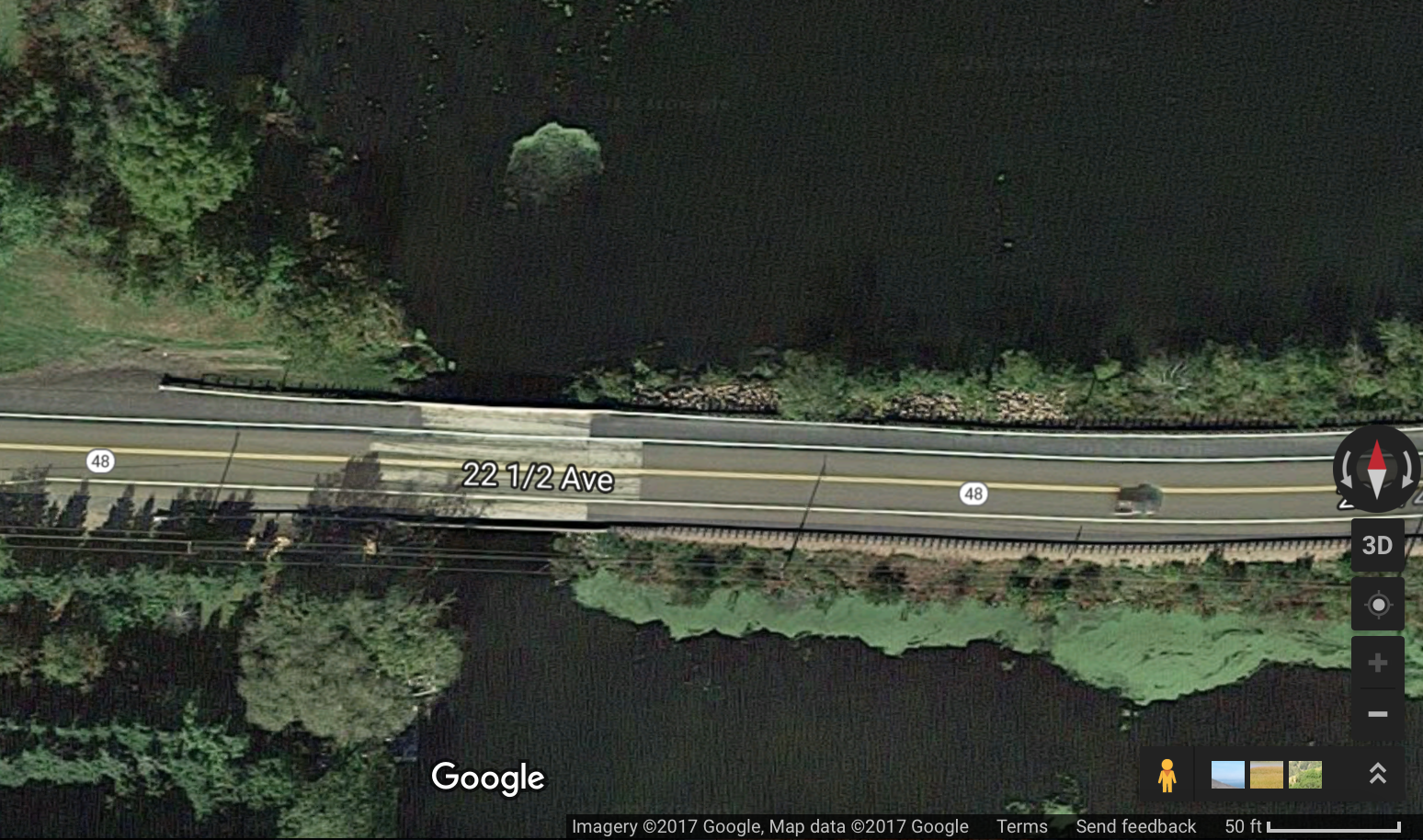 The inlet to Rice Lake (south) from Stump Lake (north) .
The inlet to Rice Lake (south) from Stump Lake (north) .
Speed is suspected and the rider's BAC was 0.216%.
Temperatures were cold from December 7 to 21. Then they hung around freezing until January 3 when they dropped to around zero for the three days leading to the accident. Inlets often have thin ice or open water, especially if they are being fed by another lake as was the case here.
January 6, 2017, 3:45 PM, Mound Ridge Kansas, Pack Pond
A family from California went 'shoe skating' on Pack Pond. The 8 year old son fell through and both parents fell through trying to rescue their son. The son and mother died. Rescue was called at 3:45 and it took about 50 minutes from then to when everyone was on shore.
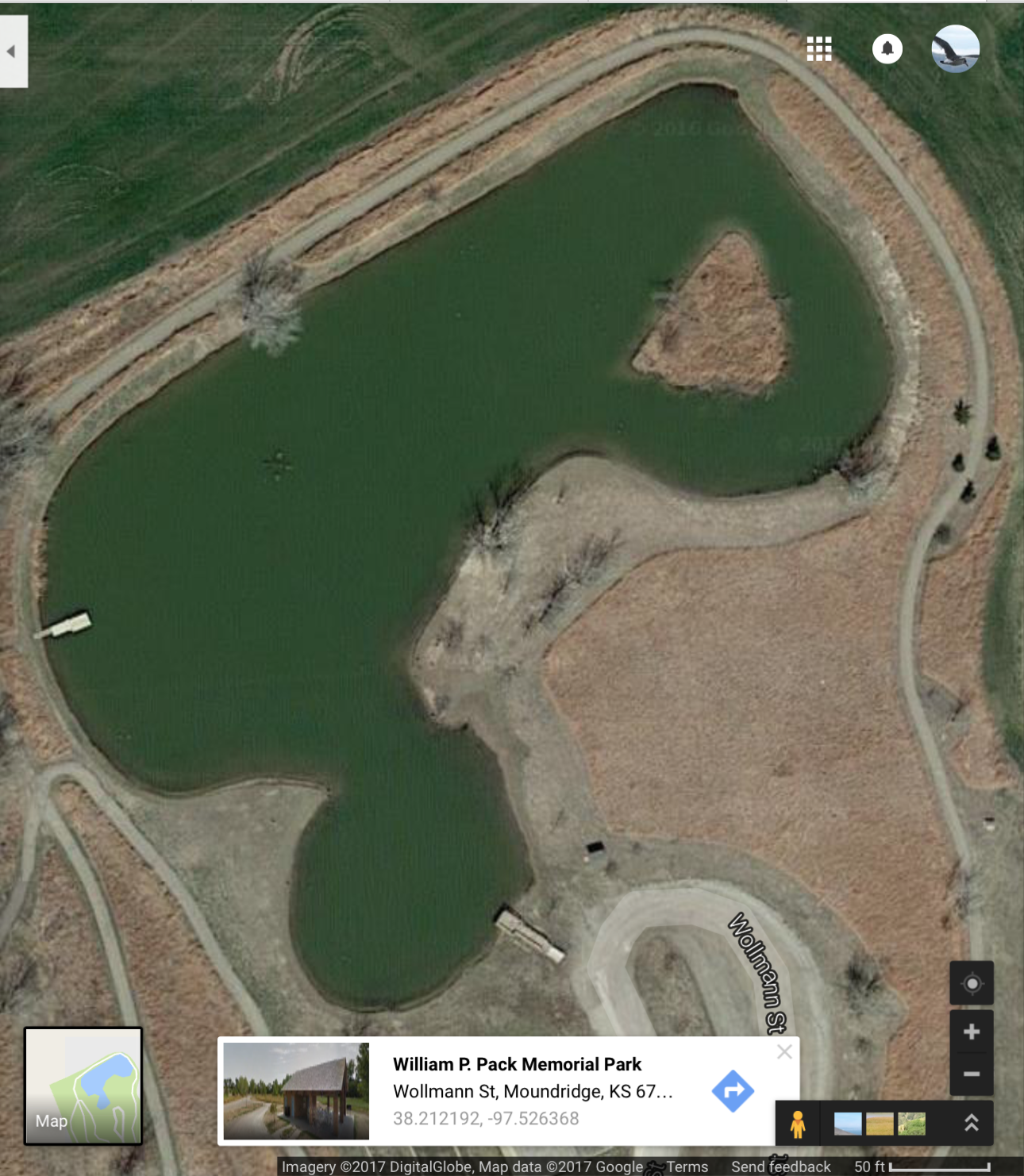 Pack Memorial Park.
Pack Memorial Park.
The ice had been in for just a two or three days according to people who lived in the area. The weather from December 21 to January 2 was mostly above freezing and averaged 40 degrees. The last three days running up to the accident enough freezing degree days to make a couple inches of ice. The pond probably caught on the third or fourth. The ice was reported to be about an inch thick.
January 7, 2017, 2:50 PM, Oakland ME, Messulonskee Lake.
A 52 year old man, riding his snow mobile, broke through on north bay near the summer boat launch. People interviewed for the news report said this is an area that local ice travelers avoid the area because of currents and dams associated with the outlet of the lake. The victim was from Massachusetts.
The weather history suggests the lake came in on either early in December or on December16. From the 17th to the 5th of January the weather was close to freezing. Roughly a foot of snow fell from December 30 to January 4. The picture in the Kennebec Journal account showed greyed out snow at the rescue site.
 The location of the boat launch is a few hundred feet upstream of the outlet dams (red marker). The lake depth adjacent to the launch is about 25 feet.
The location of the boat launch is a few hundred feet upstream of the outlet dams (red marker). The lake depth adjacent to the launch is about 25 feet.
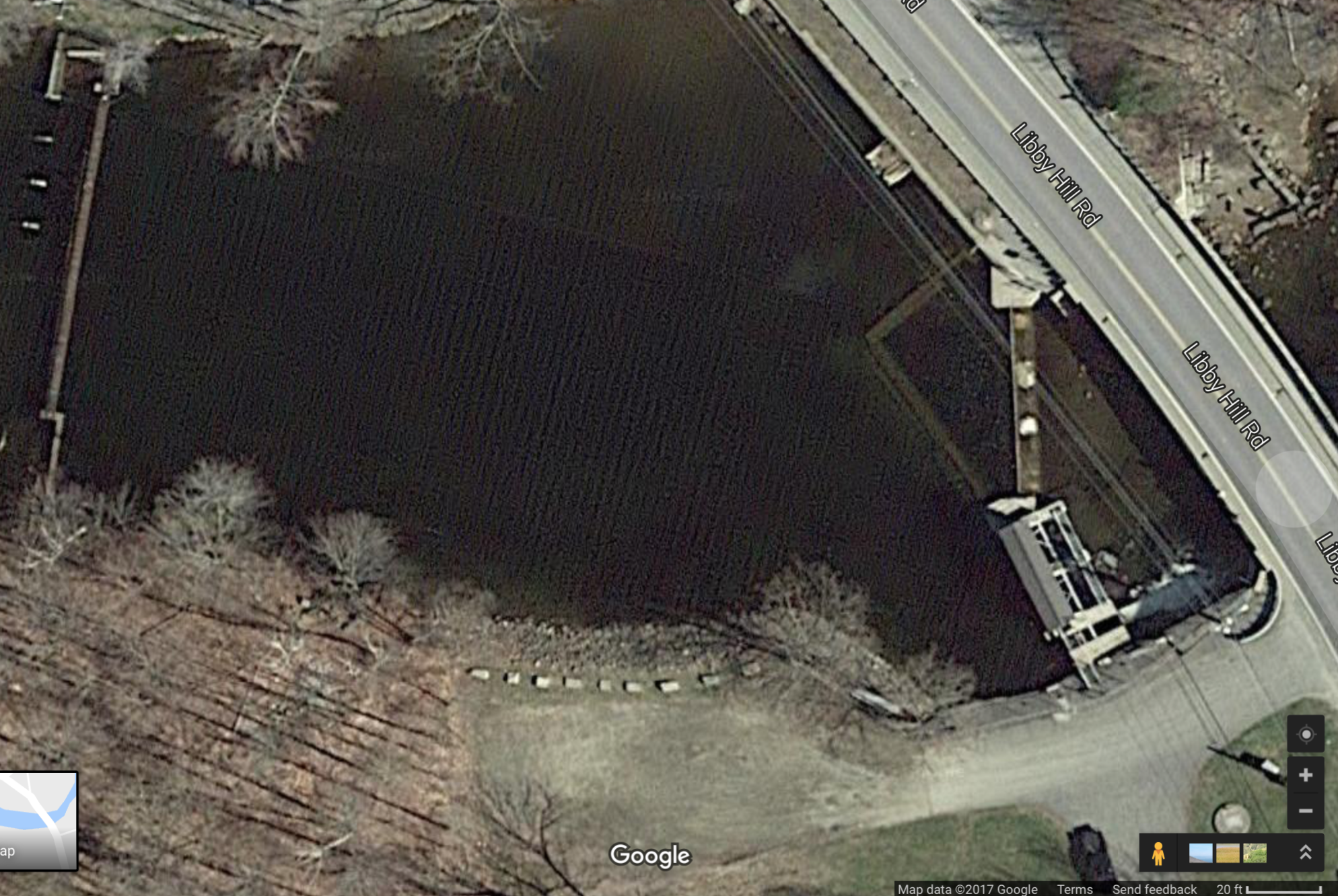
The above picture from Google Maps show the dams at the outlet to Messulonskee Lake. The dams probably create thin ice near them but not as far away as the boat launch.
Deeper, warm water (about 36 degrees) is brough to the bottom of the ice sheet where it erodes the ice sheet. A snow layer on top inhibits ice thickening from cold weather and wetted out snow prevents any ice growth that might otherwise grow ice on the bottom of the ice sheet.
January 7, 2017, 8 PM, Mayfield NY, Great Sacandaga Lake.
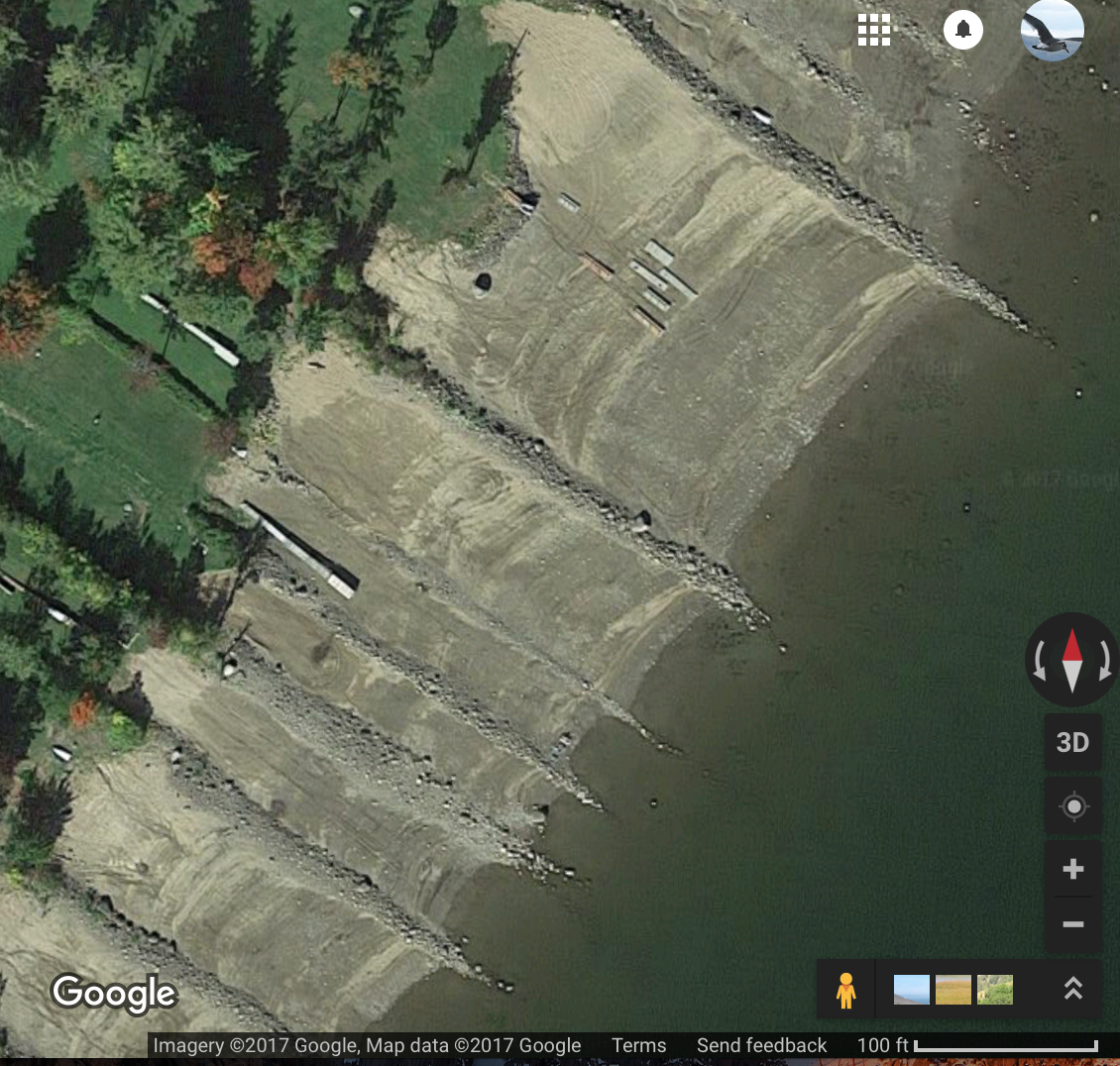 Rock on the lake bottom have been buldozed into piles like these around most of the lake. There was a similar accident on 12/24/16.
Rock on the lake bottom have been buldozed into piles like these around most of the lake. There was a similar accident on 12/24/16.
A 37 year old man hit one of the many rock piles that are exposed in the winter due to lowering of the lake for flood control. They also accumulate snow making them hard to see.
January 8, 2017, 4:10 PM, Brighton Township, MI Woodland Lake
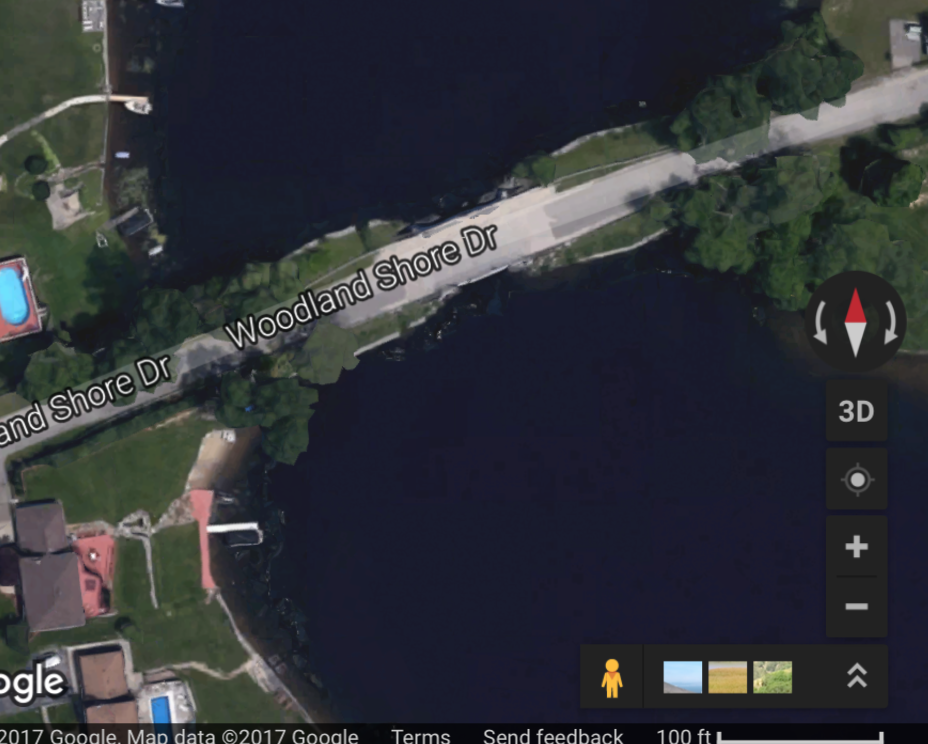 A 48 year old man, riding at high speed, collided with a bridge and was killed. The width the brididge was about 30 feet.
A 48 year old man, riding at high speed, collided with a bridge and was killed. The width the brididge was about 30 feet.
************************************************
January 9, 2017, Ferrisburg VT, Lake Champlain
A 78 year old man took a stroll on a small bay that is surrounded by cliffs and steep slopes. A neighbor saw him and said the ice had been weak and probably still was. The man had a mountaineering ice axe that he used to demonstrate the strength to the neighbor. The neighbor returned to his house. The man was nearing the west side of the bay when the ice gave way. The man was not able to get fully back on the ice and began calling for help when he realized he probably would not be able to get own on his own.
As luck would have it a woman who lived near by went out side to check her bird feeders. She heard the call for help and ran back into the house and told her husband and called 911. The husband is an outdoorsman and had a 13 foot aluminum. He tossed the into bhe back of his pickup truck and drove to a steep slope and lowered the boat to the shore. He worked his way down to the edge of the ice and pushed the boat out. He was able to get the victim to shore about the time Charlotte Rescue showed up. There was a LOT of luck in this accident.
The bay faces north and opens onto 40 miles of open water on Lake Champain. Ice in the bay is brash ice blown in and broken up by waves on the lake. A few days before the accident high temps were in the '40's which may have contributed. In addition to breaking up ice that did freeze in the bay wind would also stir the water, possibly bringing warmer/deeper to the surface.
A life jacket would have improved the victims' chance of getting out on his own. Ice claws and a better test pole and using it more would also have improved the odds. A friend with a throw rope would have helped as well. The victim used his ice axe every 50 feet or so. On dodgy conditions every 3 feet is not too much. If used properly a pole is effective for finding weak places between wind broken plates or thin plates mixed with thicker ones.
*******************************************************
January 10 2017, Bemidji MN, Pine Lake.
An 18 year old snomobile racer died in a pre-season practice run on Pine Lake
January 14, 2017, 10:20 PM, Haward WI, Lake
A 40 year old male snowmobiler was found in the remains of a burnt fishing shanty. Speed was a suspected factor.
January 18, 2017, 2AM, Sidney ME, Lake Messalongskee
A 32 year old man was riding his snowmobile at 2am with a friend on another sled. They got seporated. The man collided with the shore at high speed and was killed.
January 20, 2017, 7PM, Lac Brome, Quebec
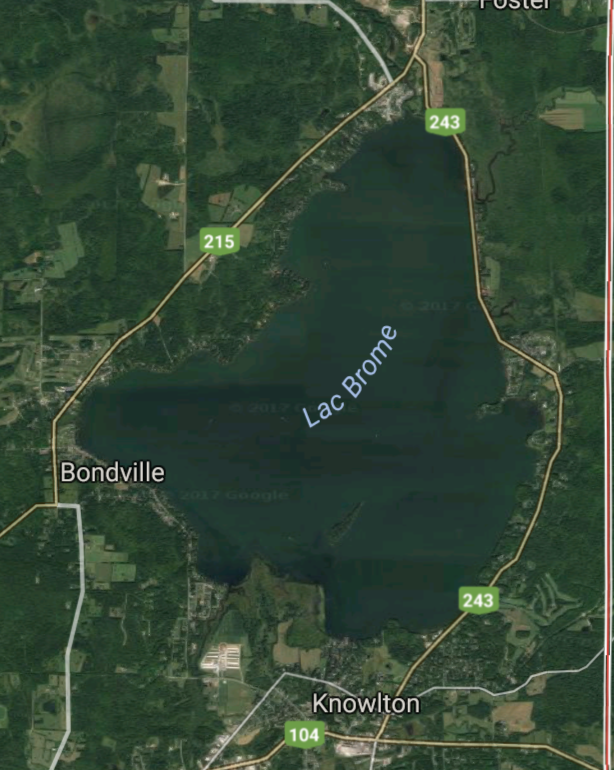
A 76 year old fisherman riding an RV broke through the ice (or drove into a hole) on Lac Brome. The victim was able to get back on the ice and call for help. He was rescued from the ice by a water rescue tream. He later died in the hospital.
Temperatures during January were cold on the 7th-10th and 14th-16th. It was warm on the 11th and 12th and sat at freezing from the 17th through the 20th. Conditions like this could have weakened ridges. Ridges probably formed during the 11th to 13th thaw. Folded ridges are particularly hard to see.
January 21, Morning, Whale Cove, Nanaut, CA,
Four men riding in an enclosed tracked snow vehicle broke through the ice on Whale Cove. One man survived and the other three are either known or presumed dead (ages 27-55). Details about he ice or weather were not reported.
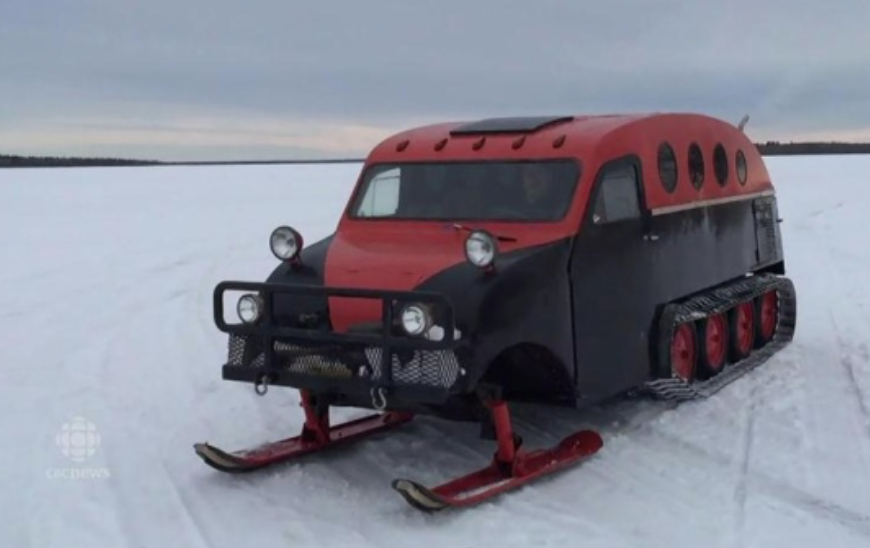 The men were hauling snowmachine and truck parts on sleds.
The men were hauling snowmachine and truck parts on sleds.
January 23, 2017, 11 AM, Cleveland NY, Sandy Pond
Two fishermen (64 and 62) fell through the ice. Someone saw or heard them and called 911. When Rescue arrived one of the men was under water and the other was still hanging onto the ice edge. He lost his grip before rescue personnel could get to him.

The ice had 38 thaw degree days on it. In rough terms that is enough to melt 6" of ice (and weaken what is left). The average temperature had not been below freezing for 6 days. The high temp was above freezing for the past 14 days. The three days before the accident were atleast partly sunny.
Life jackets, float coats or flotation suits would have saved the men. Ice claws or throw ropes would have made survival significantly more likely.
January 24, 2017, 6:30 PM, Shell Lake (town), WI, Long Lake
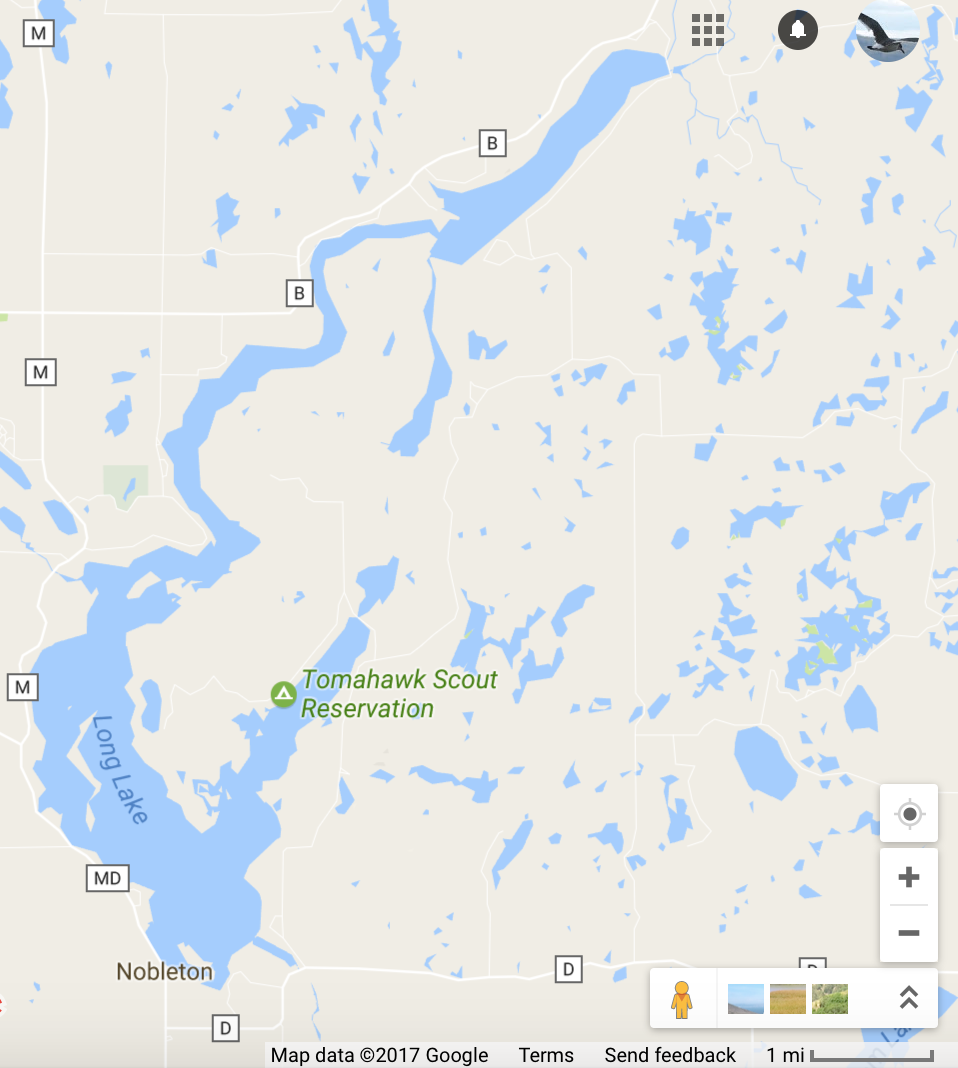 Long lake WI
Long lake WI
A 60 year old man drove his truck onto the ice of Long Lake. He was doing donuts. A witness observed the noise stopping and the lights disappearing. He walked out and found tracks leading to a hole. The truck was found in 40 feet of water and the victim was found under the ice in 24 feet of water.
There was plenty of cold weather to make thick ice from Janaury 3 through the 16th. The last 8 days running up to the accident was cloudy/foggy and hovered near 32 degrees. Ridges can weaken significanly in this condition.
January 25, 2017, 1:20 PM, Anchor Bay, Lke St Clair, New Haven MI. A fisherman who fell though the ice was noticed from shore. 911 was called about 1:20 PM. He was fishing a few hunred yards furhter out than other fisherman. They tried to get to him but the ice was too weak (demonstrated with a single poke of a spud).
The temperature was above freezing night and day for 9 days leading to the accident.
January 25, 2017, 7AM, Linn MN, Lake Geneva
A 60 year old fisherman went out on Lake Geneva at about 3 AM. Rescue was when the man's wife was unable to get through to his cell phone. A drone with an IR camera was used to find a faint heat signature and the point where he broke through. He was found about 1000 feet off the south shore of the lake.
The average temperatures for nine days before the event averaged above reezing.This is a relatively deep lake and it often comes in in stages. This weather pattern is clear indication to expect trouble.
Ice claws and a life jacket would have improved the odds but being off shore, alone, and in the wee of the the morning stacked the odds against him.
January 26, 2017, Powassan ONT, Hydro Pond

An 82 year old man was driving a tractor on the hydropond when he broke through the ice. He was found in the tractor cab. The weather history for Powassan shows the same prolonged warm spell seen in the midwest. Light snow fell frequently on the pond insulating the ice from growth in general all though it may have facilitated snow ice formation (and periods of layered ice).
Tractors generally have a very short float time. A cab interferes with getting away from the plunging vehicle.
January 26, 2017, 9AM, Lake Willoboughy Vermont.
A 62 year old fisherman broke through the ice on one of Vermont's deepest lakes. This incident has an important message about ice weakening in a prolonged period of near freezing weather combined with layered ice (slush over black ice). It is also an example of the value of flotation for people on foot.
The ice probably came in on the 14th (maybe the 15th?). In the nine days running up to the accident, average temperatures hovered near freezing. (charts from Weatherunderground.com)
Winds have a lot to do with cooling the lake before it freezes, preventing catching in windy cold spells and thawing the surface ice on warm days. Lake Willoughby runs north-south and cuts through a local mountain range so winds from the north and south are particularly strong.
Wind directions before the accident.
Small amounts of snow fell on most of the days leading up to the accident. Based on MODIS satilite images, cloud cover was mostly 100% but a couple of days might have had a little bit of sunshine.
The shore line near the accident is either cliffs or steep slopes. Before the accident, the fisherman was fishing off a camp that was being rebuilt. The area has very few winter residents. The fisherman moved south far enough that the workmen couldn't see him. The job involved a skidder. One of the men thought he heard someone calling. They stopped the machine, located the source of the calls for help and went into action. The men had to find a reasonable access point The fisherman was still calling for help when the men arrived but stopped shortly thereafter. They attempted to go out to the fisherman but the ice was giving away. Rescue arrived with ice rescue suits and recovered the fisherman. They reported the ice was about an inch thick.
I looked at the ice the next day. I did not approach the accident site as it had not been cold enough to strengthen/thicken the ice. I did get about 20 feet onto the new plate and found layered ice. The bottom two inches was black ice (type S1). There was an inch of snow ice above that. Above the hard ice there was 3/4" of slush and about 1-1/4" of weakly frozen slush. The total thickness is 5" but only 2 or 3" of that contributed any real strength. I tried cutting out a 4" by 20" beam for strength testing but it had enough internal melting that it broke as it was sawed. In similar conditions at an accident on Lake Dunmore in 2010, I found that the thickness of the black ice layer was irregular. It was thought by the people I talked to at Lake Willoboiughy that the thickness decreased as you got closer to shore and that the fisherman was moving toward shore when he broke through. In some places along the shore, there was no ice. There was open water near the accident site and there was what looked like an snow/slush covered folded ridge. There may have been other weak areas that were covered by the slush layer.
Lessons:
- A life jacket or float coat would have saved the day. I have seen a few fishermen wearing them in spite of the fact that they usually have a story about falling through.
- Ice claws might have been enough.
- Layered ice (black ice under slush under frozen slush) is involved on a fair number of accidents. Circumstances and data from this and other accidents suggests that there may be significant weakening of black ice during prolonged periods of having water under and over it.
- When the ice sheet is covered with snow/slush you can't see many of the clues that indicate problems with the ice.
- The best way to look for layering is to cut out a piece of ice. Fishing ice saws are best but they are heavy and cost $120. a folding brush saw works OK for total thickness less than about 5".
- When drilling a hole, the augur will drop when it hits a slush layer. You can use a finger to find the depth of the slush layer. Pull the augar out and measure the depth to the bottom of the slush layer. This will give let you calculate how thick the black ice layer is. 5" of black ice in layered ice is probably a reasonable minimum unless the ice is coming out in chunks instead of shavings. If the black ice layer comes out as chunks or is less than 5" the best bet is wait until the ice is completely frozen.
February 4, 2017, probably day time, Tupper Lake, NY, Raquette Pond
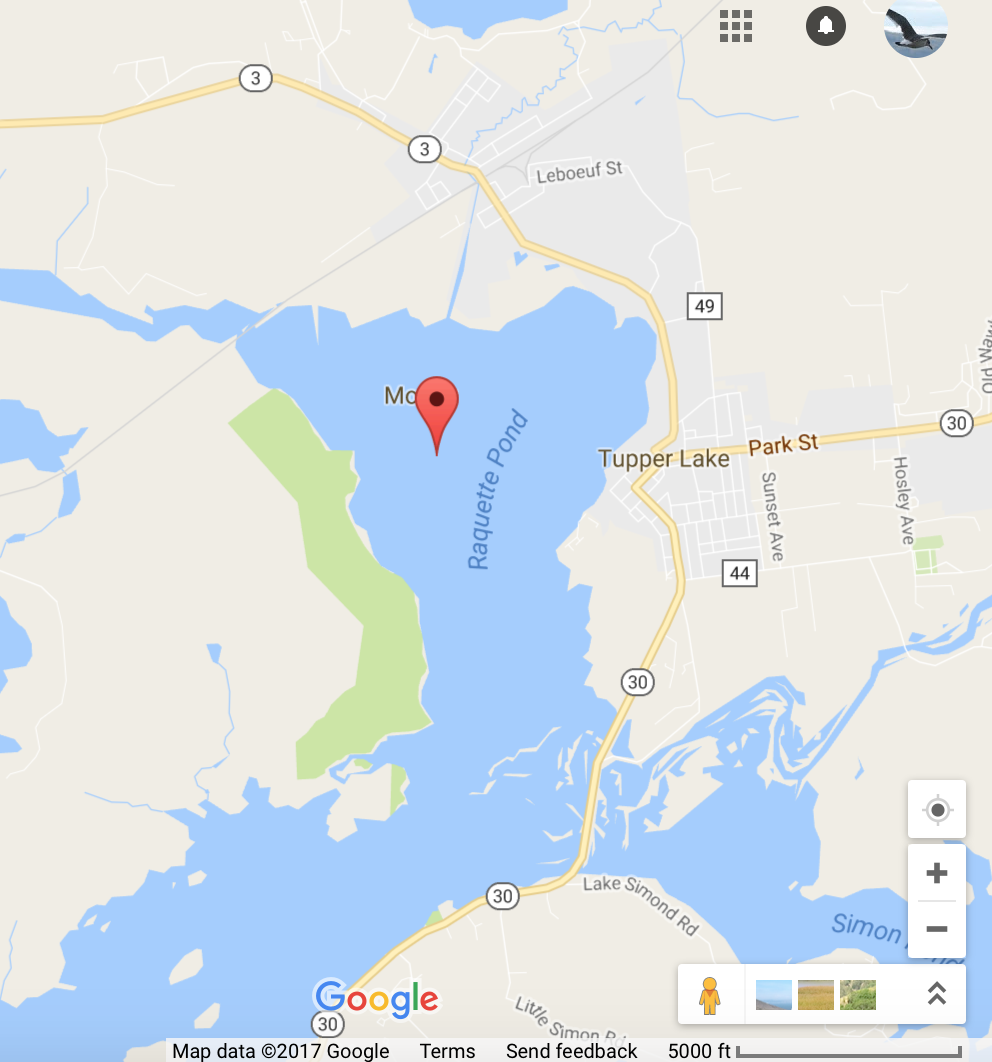 Raquitte Pond is the upper part of Tupper Lake. The Raquette River flows in from the bottom right and out at the upper left.
Raquitte Pond is the upper part of Tupper Lake. The Raquette River flows in from the bottom right and out at the upper left.
Two brothers ages (64 and 67) were riding on Raquette Pond which was known to have thin ice. When they did not come home that evening their wives called Rescue.
February 6, 2017, About 2:PM, Dashina IL (western IL), strip mine lake.
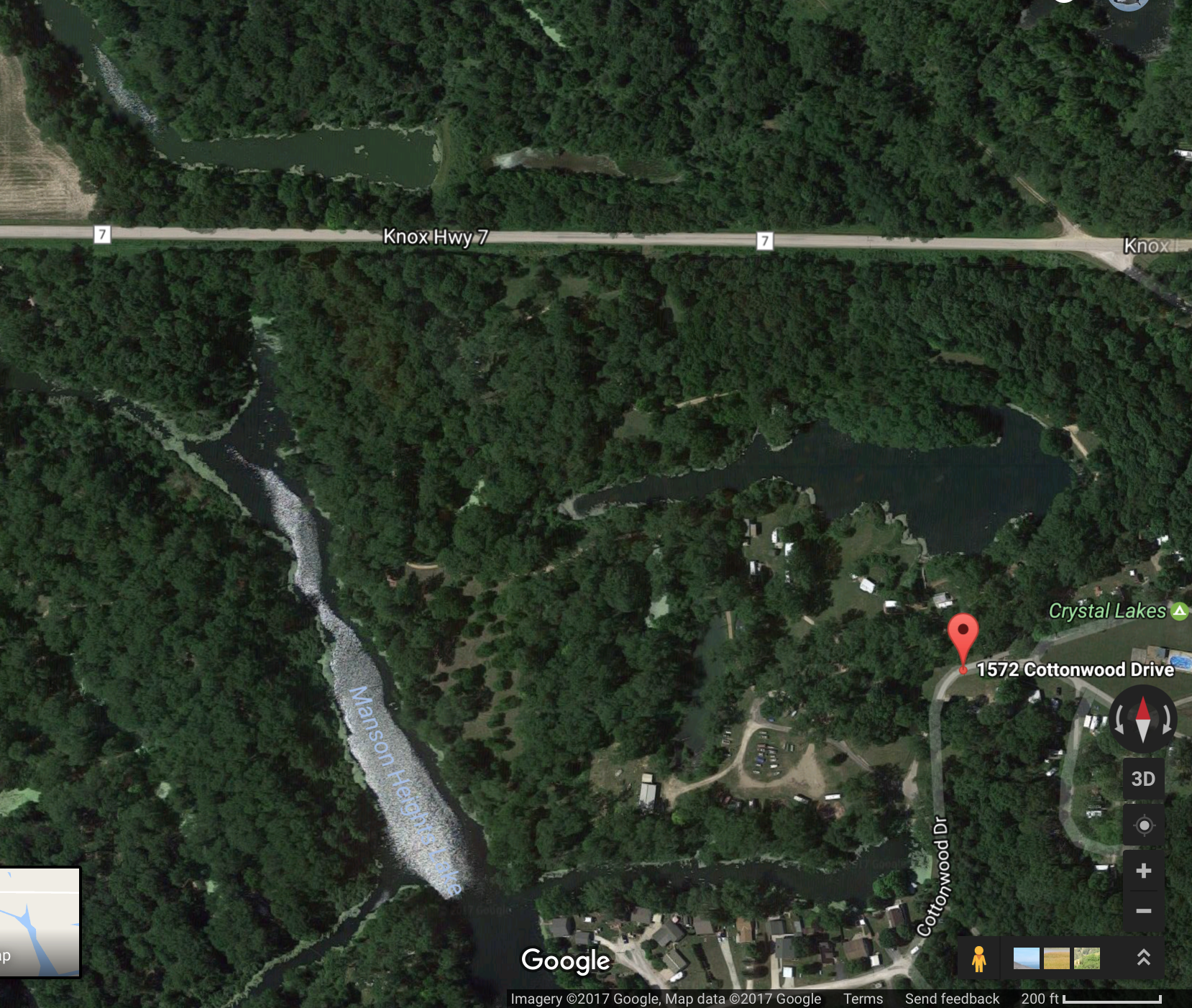 The red marker is where 911 was called to.
The red marker is where 911 was called to.
Two fishermen were fishing on a small lake. As they were preparing to leave one of them fell through. His buddy attempted to rescue him however he also broke through. He was able to self-rescue however the first man was not. He was found submerged in 16 feet of water.
On February 5th it got to 40 degrees and on the 6th it got to 53. (chart and data from weatherunderground.com)
The weather for the month preceding the accident had four thaw periods with three times that it touched 15 degrees for a few hours. The ice may have come in as late as February 2 in which case it was cold enough for three days (2nd-4th) to make about 2" of ice. It went above freezing the afternoon of the 4th and mostly stayed there. On the night/early morning of the 5th and 6th it dipped below freezing for about 12 hours which would have hardened up the ice sheet. It reached 53 degrees at the time of the accident and and may have been sunny part of that time. Thin ice sheets weakend quickly on those conditions.
Life jackets, ice claws and throw ropes all would have probably changed the outcome.
February 10, 2017, 8:30 PM Williamsburg, MI, Lake Skegemog
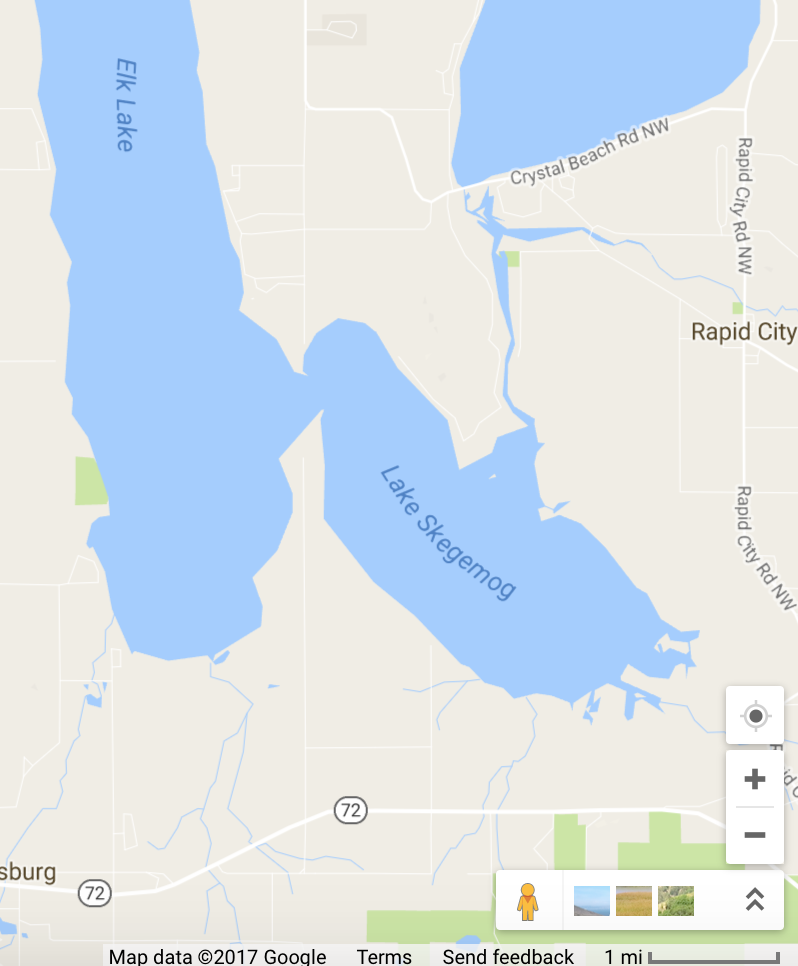
A 34 year old fisherman rode his sled off the ice into open water. It sounds like the rider may have been riding in the narrows between Lake Skegemog and Elk Lake. The narrows is often open. The lake is fairly shallow: 25 feet in the northern half and 11 in the southern half. Elk lake, is is
Rescue was not able to get to him fast enough to save him. A life jacket probably would have saved his life.
This is lake effect snow county and it snows some most days. January was warm and February not particularly cold.
February 10, 2017, 10:30 PM, Fifield WI
A 31 year old man hit another sled.
February 11, 2017, 4 PM, Meredith NH, Lake Winnipsaukee.
A 15 year old man and his father was participating in the Meredith Fishing Derby with his father. They decided to go for a ride on their sleds. They both broke through. The father was rescued. His son was revcovered from water that was 73 feet deep.
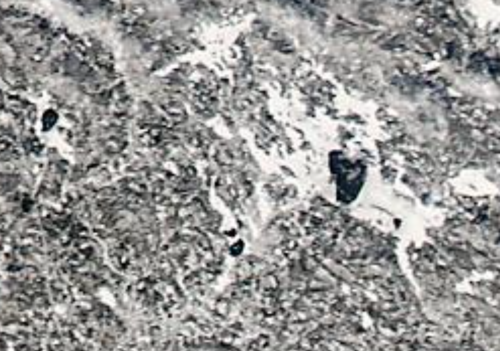
The deeper parts of this large lake appear to be open or very recently frozen over. Lake Winnisquam and Newfound Lake also appear to have open water/thin ice.
The weather history shows a long period of near freezing temps in the middle of January. In early February there were a series of sunny days, getting to 47 degrees on the 8th. Snow fell on the lake during the colder weather near the time of the accident. This would insulate the ice from the cold air 9th to the 11th.
The all up weight of a snow machine and rider is on the order of 700 lbs. The break through thickness is a little over 2" IF the ice is cold and it does not have major imperfections like wet cracks.
February 10, 2017, 10:30
February 11, 2011, Daytime, Moultonborough-Gilford, NH, Lake Winnipsaukee, The Broads

Three men riding snowmobiles between Long Island and Sandy Island when the drove off the ice sheet into open water. The location was described as about 300 yards from Long Island with a water depth of 40-50 ft. Witnesses said it was hard to tell ice from water until you were close. One of the riders was able to pond skim to Sandy Island. The other two (ages 62 and 67) were not successful and they drowned. See the Modus picture in the previous accident to see the open water on the Broads.
This and the previous accident were thought to be the largest single day fatalites on any New Hampshire lake.
February 9, 2017 (late afternoon or evening) Orwell, VT, Lake Champlain
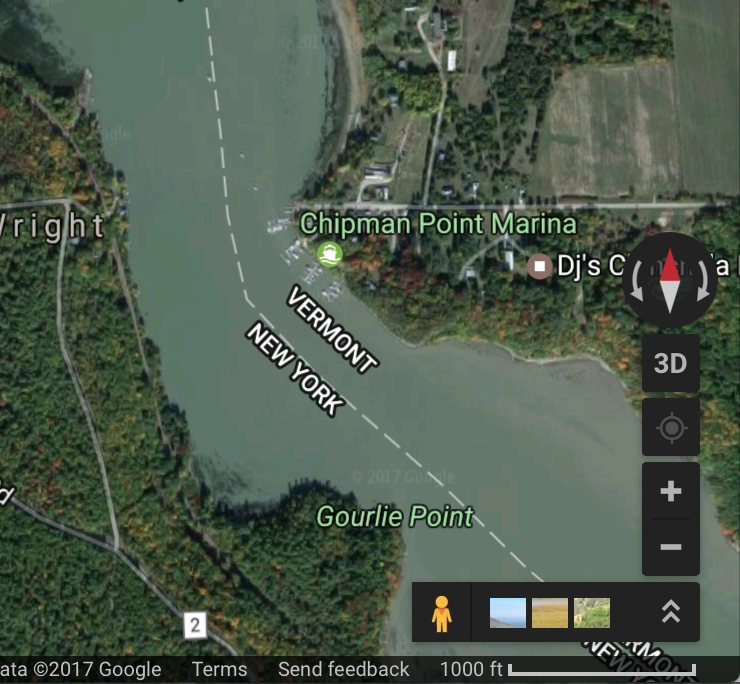
The area around Chipman Point
Two snowmobilers (ages 23 and 32 and on two sleds) headed out from Benson Landing on the way to a resturant in Ticonderoga. The distance to Ticonderoga is about 10 miles. They did not arrive. As of Feb 15, the snowmobiles and some gear has been found near Chipman Point and one man was recovered. Chipman point is a narrow point in the lake. This part of Lake Champlain has some river like qualities. It has enough flow for turbulance to disrupt the stable layer that occupies the top few feet of most lakes. When that layer is disrupted, warmer, deeper water gets transfered to the bottom of the ice sheet. This narrow part of the lake runs from the Champlain Bridge to Whitehall NY.
The lake, south of the bridge is one of the first places to get ice on Lake Champlain, usually in December. The area around Crown Point NY often has thin ice and open water. It is the first of several narrows in the lake. Five mile point almost always has open water. It is usually necessary to go to shore and hike for a while to get past this section of the lake. Chipman point is the second narrowest place north of Benson Landing. It often has one or more ridges crossing the lake. Often they are folded ridges and require walking around the end on land. South of Benson Landing the lake is very narrow.
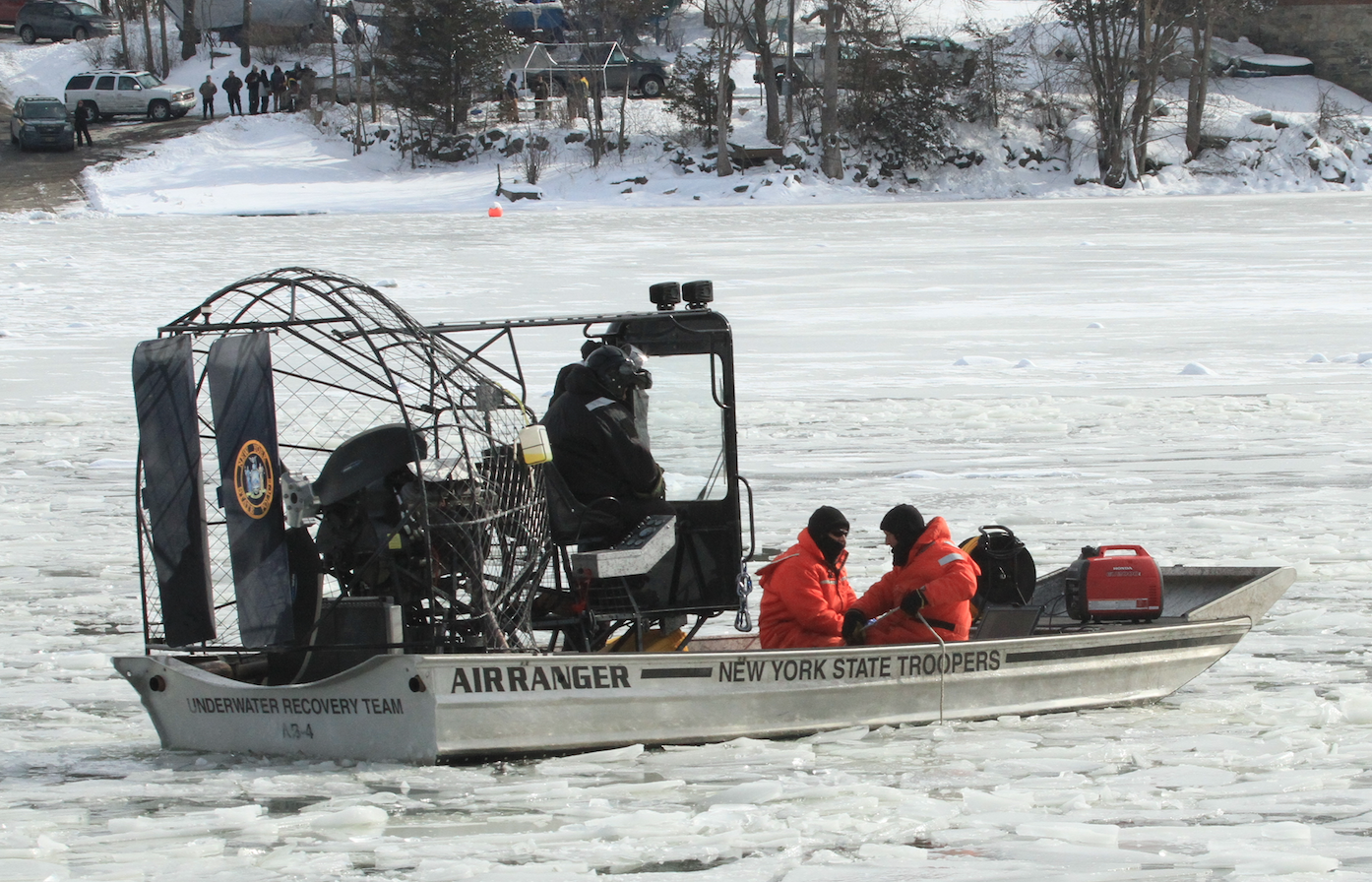 The two air boats were used to break up the ice making it safer to work under. You can get a sence of the thickness of the plates (very roughly1.2 to 2.5") The breakthrough thickness for a snomobile on cold black ice is about 2.5". About three miles north a fishermen reported he was drilling through about 11". This suggests there has been significiant underice erosion around Chipman Point.
The two air boats were used to break up the ice making it safer to work under. You can get a sence of the thickness of the plates (very roughly1.2 to 2.5") The breakthrough thickness for a snomobile on cold black ice is about 2.5". About three miles north a fishermen reported he was drilling through about 11". This suggests there has been significiant underice erosion around Chipman Point.
Feb 15 update: Several ice samples from the Vermont side of the lake show a thickness of about 2-1/4" all of which is snow ice except for about 3/8" of black ice (S2) on the bottom. It most likely grew after the accident. I attempted to saw out a beam to test flexual strength but the ice broke repeatedly. The ice was under slush when I was sawing it.
 It has been a warm winter with relatively little snow. This weather pattern has been a probable contibutor for about 16 fatalities so far this season, Seven of them involving sleds in four accidents on the same day. Life jackets, ice claws and throw ropes would have saved a lot of lives.
It has been a warm winter with relatively little snow. This weather pattern has been a probable contibutor for about 16 fatalities so far this season, Seven of them involving sleds in four accidents on the same day. Life jackets, ice claws and throw ropes would have saved a lot of lives.
February 11, 2017, after dark, Lakeville, NY, Conesus Lake.
(the red marker is not the accident site)
Two men (age: 40) went for a night snomobile ride on February 11. Their helmits were spotted with a drone. One account described the ice as slushy in places. it melted substantially leaving lots of open water by the 22nd

The 30 days before the accident had a net 24 thaw degree days. Two days before the accident the the running total was 48.
There were seven breakthrough fatalities , all on sleds, all within three days, and all due to thinner/weaker ice than some people expect to find in mid winter. The others are reviewed in the previoius three reports.
February 14, 2017, 5:00PM Macomb NY Black Lake
A 38 year old man was riding a snomobile on Black Lake. He was killed when he collided with a pile of rocks along the shore.
February 16, 2017, 6:45 PM, Port Perry, ONT, Lake Scugog, View Lake area
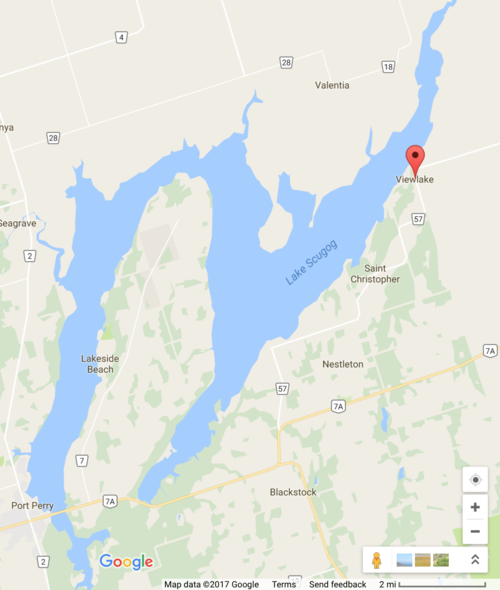 The Scugog River feeds into Scugog Lake in the area where the accident occured.
The Scugog River feeds into Scugog Lake in the area where the accident occured.
A 16 year old woman was a passenger on a sled with her boyfriend. They drove into open water. Property owners on shore heard the sled go through and were able to coach the young man on what to do and where he could stand up in shallow water. A rope was used when he got close enough to shore. The 16 year old woman was not able to self rescue and she did not survive. A second sled was able to stop before going into the open water.
The open water was attributed to the flow of the Scugog River. The river exits from a large lake 9 miles upstream. Water coming out of the lake is probably about 35 degrees. Snow was mentioned in the weather history on 2/3 of the previous 31 days. Snow insulates the ice sheet, reducing growth during cold weather. There were numerous warm spells in the month prior to the accident.
Flotation snowmobile suits, life jackets or float coats most likely would have saved the day. Ice claws might have helped.
February 19, 2017, 5 PM, Waterford ONT, Waterford North Concervation Area
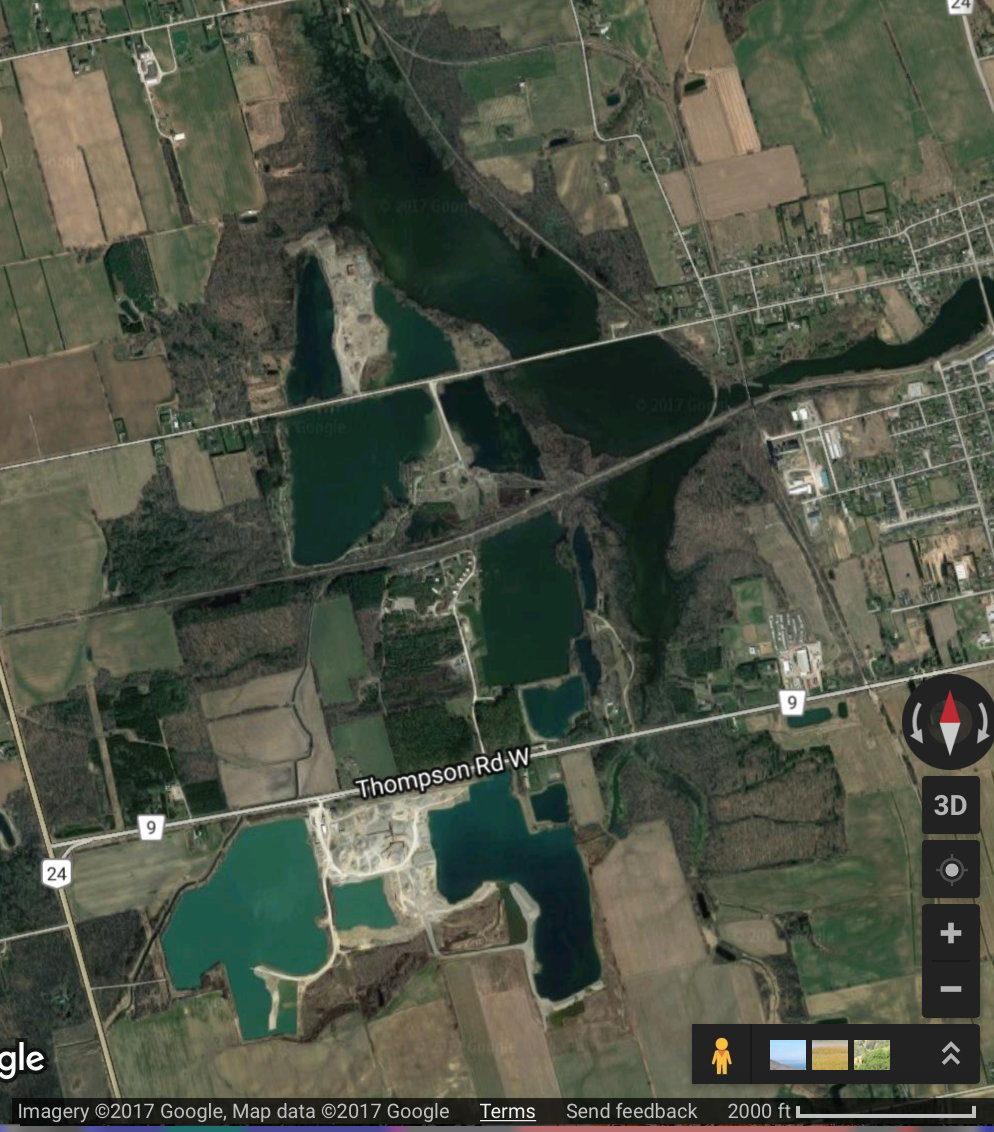
A 68 year old man was fishing and a 9 year old relative was skating on the ice of a quarry pond. The man broke through late in the day. The 9 year old attempted to help but ended up in the water to. Bystanders rescued the boy but were not able to rescue the man. He submirged by the time rescue arrived.
It was a warm, sunny day (mid 50's) as was the 18th with an overnight temperature in the mid 40's. There were above freezing days and nights during the previous month. Open water was reported on other parts of the pond. The late February sun is much stronger than earlier in the season. It can weaken ice thinner than three ices in a couple of hours or less. Skating on wild ice requires tools and skills that are discussed at length on other pages on this website: Test poles, life jakets, ice claws, throw ropes, knowlege of ice and current and recent weather, etc.
A lifejacket would have saved the day as would ice claws or throw ropes.
February 20, 2017, 5:50 PM, New York City, Central Park, The Pond
Six children (ages 6 to 15) gathered for a selfie on the ice and the all broke through. They were rescued by bystanders, themselves and each other.
February 20, 2017, Airdrie ALB, 1:15 PM, Drainage pond.
A 6 year old boy and his 10 year old brother fell through thin ice on a drainage pond. The 6 year old did not survive.
Temperatures from the 10th to the 17th were above freezing peaking at 61 degrees on the aftternoon of the 15th. From the 18th to 20th there was enough freezing degree days to make about an inch of ice. Also, the pond may have developed active convection as a result of the strong sun on five of the days running up to the accident. The bottom line is the beginning and end of the ice season are particularly prone to thin ice from a short cold spell that leaves thin ice or ice that is weakened from strong sun and warm air.
February 19, 2017, Alton NH, Lake Winnipseauke NH, Alton Bay
An experimental plane flipped over on a runway plowed on the lake while the pilot was moving the plane away from the landing area,. It was a warm, sunny day. I
March 10, 2017, mid afternoon, Atkin County, MN, 12:11 PM, Sandy River Flowage
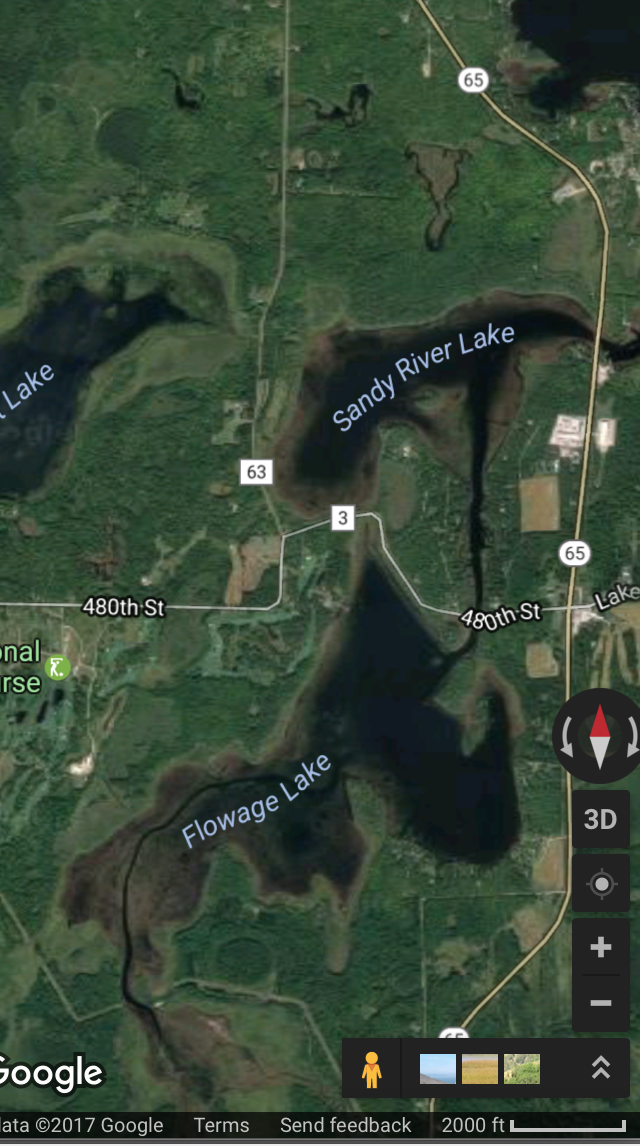
A 59 year old man broke through ice described as from 3" to 1/2". He had a cab on his machine and was found inside it in 8 feet of water.
There were two significant thaws in February and another long one in January.
No cab to be trapped in, flotation and ice claws probably would have saved the day.
March 10, 2017, daytime? Big Rideau Lake, Ont
Two men (69 and 72) broke through the ice somewhere around Cow Island. A pressure ridge is a good candidate for the weak spot they found. Life Jackets, ice claws and knowing how to exit a vehicle through the windows might have saved the men.
March 11, 2017, daytime, Westport ONT, Buck Lake
A 61 year old man riding an ATV broke through the ice. His helmit and machine were found floating on the surface. The accident occured at a narrow part of the lake. No details about the ice condition were given.
Narrows claim a lot of lives, especially in Canada which has a lot of lakes, many of which have narrows in them.
Flotation and ice claws probably would have saved the day.
